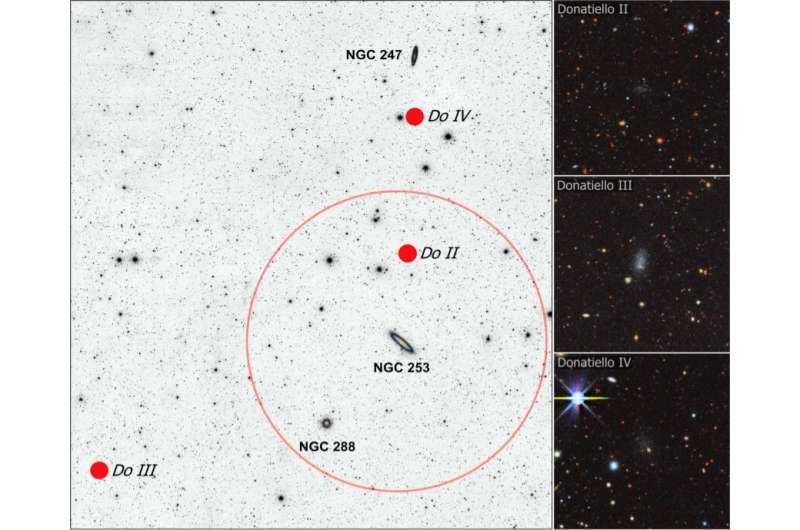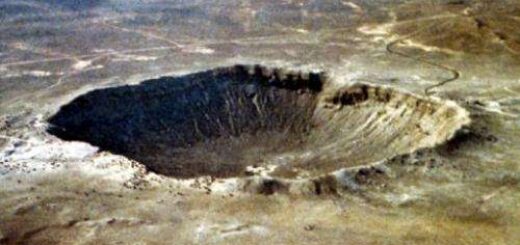Astronomers discover three new faint dwarf galaxies

By analyzing the data from the Dark Energy Survey (DES), an international team of astronomers has conducted a search for nearby faint dwarf galaxies. In result, they detected three such objects around the Sculptor Galaxy. The finding is reported in a paper published June 16 on arXiv.org.
Containing up to several billion stars, dwarf galaxies are difficult to detect due to their low luminosity, low mass and small size, and are often found as companions to larger galaxies. Given that the evolution in such dwarfs occurs without any external influence, they could be crucial in improving our understanding of star formation processes in galaxies.
At a distance of around 12 million light years from the sun, the Sculptor Galaxy (also known as NGC 253) is an intermediate spiral galaxy in the constellation Sculptor. The galaxy has a radius of approximately 86,000 light years and is currently undergoing a period of intense star formation.
NGC 253 is one of the closest spiral galaxies and therefore could be a great place to search for new low surface brightness (LSB) dwarf galaxies. A team of astronomers led by David Martínez-Delgado of the Institute of Astrophysics of Andalusia, Spain, has now investigated NGC 253 and its surroundings with the aim of finding new dwarfs of this type.
“In this paper, we report the first results of a systematic survey of faint dwarf spheroidal galaxies in the vicinity of the bright late-type spiral NGC 253 galaxy by means of a visual inspection of the images taken by the Dark Energy Survey,” the researchers wrote in the study.
The astronomers detected three new faint dwarf spheroidal galaxies in the vicinity of NGC 253. The newly found dwarfs, designated Donatiello II (Do II), Donatiello III (Do III) and Donatiello IV (Do IV), have absolute magnitudes in the range from about −7 to −9 mag, what is typical for satellite dwarf galaxies in the local universe.
According to the study, Do II, Do III and Do IV have effective radii of approximately 323, 495 and 596 light years, respectively. The central surface brightness of these galaxies tend to be extremely low, as it was estimated to be within the range of 25–26 mag/arcsec2 in g-band.
The astronomers assume that Do II, Do III and Do IV are satellite galaxies of NGC 253; however, further observations are required in order to confirm this.
“Because of the low surface brightness of the three dwarf galaxies reported here, their association with NGC 253 can be only confirmed with TRGB [tip of the red giant branch] estimates in CMDs [color-magnitude diagrams] from deeper HST [Hubble Space Telescope] data and ground-based 8-meter telescopes or, alternatively, radial velocities obtained with state-of the-art spectroscopic instruments,” the scientists explained.
If the newly detected dwarf are satellites of NGC 253, the total number of the galaxies associated with the Sculptor Galaxy would be 16. The authors of the paper calculate that the total mass of this NGC 253 group would be at a level of 800 billion solar masses.



 Creators of mankind
Creators of mankind Description of “Tall white aliens”
Description of “Tall white aliens” Where they came from?
Where they came from? About hostile civilizations
About hostile civilizations The war for the Earth
The war for the Earth “Tall white aliens” about eternal life
“Tall white aliens” about eternal life Video: “Nordic aliens”
Video: “Nordic aliens” Aliens
Aliens Alien encounters
Alien encounters The aliens base
The aliens base UFO
UFO Technology UFO
Technology UFO Underground civilization
Underground civilization Ancient alien artifacts
Ancient alien artifacts Military and UFO
Military and UFO Mysteries and hypotheses
Mysteries and hypotheses Scientific facts
Scientific facts


















